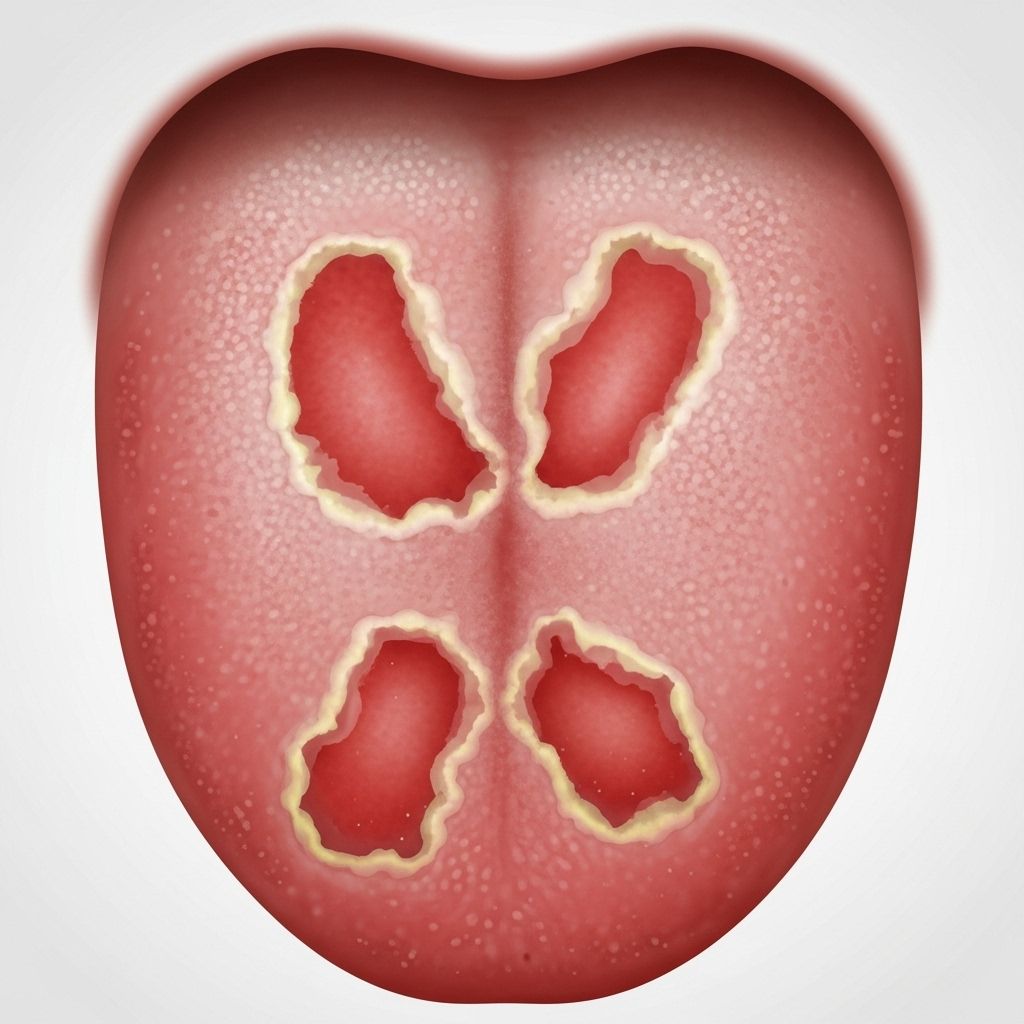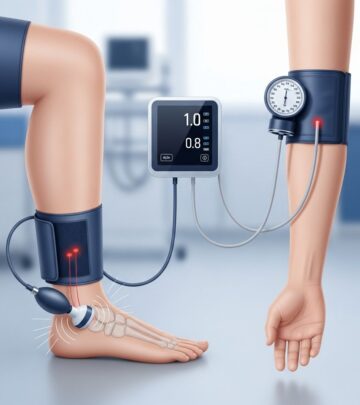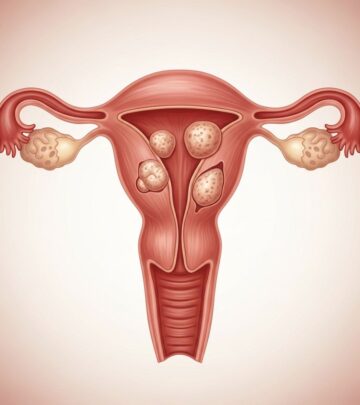Geographic Tongue: Symptoms, Causes, and Guidance
A comprehensive overview of geographic tongue, from symptoms and causes to diagnosis, management, and when to seek medical advice.

Geographic tongue is a common but benign condition that affects the surface of the tongue, often causing patches that resemble a map. This condition, while visually striking, is not associated with serious health risks or cancer. Below, you’ll find an in-depth exploration of the symptoms, causes, complications, risk factors, and much more surrounding geographic tongue, organized under clinical and patient-friendly headings.
Overview
Geographic tongue, also known as benign migratory glossitis, is distinguished by smooth, red patches on the tongue surrounded by slightly raised borders. The affected areas are missing papillae—the tiny, pinkish-white, hairlike bumps that typically cover the tongue’s surface. These patches create a maplike appearance, hence the name “geographic tongue.” The patches can move or change location over time and sometimes shift in size and shape.
- Prevalence: The condition occurs in individuals of all ages, but it is slightly more common in younger adults. It affects both men and women, and there is no significant preference for race or ethnic background.
- Nature: Geographic tongue is harmless, not contagious, and unrelated to oral cancer or infection. However, some people may experience discomfort or heightened sensitivity to certain foods.
Symptoms
The signs and symptoms of geographic tongue are varied and may come and go over time. It is possible for the condition to persist for days, months, or even years, frequently resolving spontaneously before recurring.
| Symptom | Description |
|---|---|
| Smooth, Red Patches (Lesions) | Irregularly shaped areas lacking papillae appear as smooth, red ‘islands’ mainly on the top or sides of the tongue. |
| Frequent Change in Lesions | Patches often migrate, altering in size, shape, and location over time. |
| Borders | Patches typically have slightly raised, white or grayish borders. |
| Pain or Discomfort | Some individuals may notice burning sensations or discomfort, especially when consuming spicy, acidic, salty, or hot foods. |
| Sensitivity to Foods | Increased sensitivity to spices, salt, sweets, and acidic foods may be reported. |
- It is common for many people with geographic tongue to have no symptoms at all, discovering the condition only through a routine dental exam.
- The problem often resolves on its own but may reappear later in life.
When to See a Dentist or Doctor
- Geographic tongue itself is generally a minor and harmless condition. However, lesions on the tongue may sometimes signal more serious health conditions or oral diseases.
- If you have tongue lesions that do not improve or disappear after 10 days, or if you notice unusual pain, swelling, whiteness, or changes that interfere with eating, seek medical evaluation.
Causes
The precise cause of geographic tongue remains unknown. No clear environmental or lifestyle factor has been identified as the direct source. Notably, current evidence suggests:
- Genetic Component: Some families report multiple members with the condition, suggesting a possible inherited predisposition.
- Association with Other Conditions: There may be links between geographic tongue and chronic inflammatory conditions, including:
- Psoriasis: Geographic tongue occurs more frequently in people with this skin disorder, particularly those with plaque psoriasis, but not everyone with psoriasis develops geographic tongue.
- Lichen Planus: A chronic inflammatory condition of the mouth sometimes resembles or co-occurs with geographic tongue.
- Nutritional Deficiencies: Low levels of certain nutrients—such as zinc, iron, folic acid, and B-vitamins (including B6 and B12)—may increase susceptibility in some individuals.
More research is needed to clarify these connections. Notably, geographic tongue is not caused by an infection, poor oral hygiene, or cancer and is not contagious.
Risk Factors
Although research has produced mixed findings on who is most likely to develop geographic tongue, some risk factors have been proposed:
- Family History: A hereditary component is suspected since the condition can run in families.
- Fissured Tongue: People with “fissured tongue”—characterized by deep grooves across the upper surface of the tongue—often also exhibit geographic tongue.
- Age and Gender: Slightly higher prevalence is observed in younger adults, with a marginal difference in gender susceptibility.
- Nutritional Status: Deficiencies in vitamins and minerals may be a contributing factor.
Complications
Geographic tongue does not pose a threat to overall health, nor does it increase the risk of serious medical problems. However, there are notable psychosocial effects:
- Cosmetic Concerns: The visible appearance of the tongue can be embarrassing to some, especially if the lesions are prominent or spread to visible areas.
- Anxiety and Uncertainty: Fear that the condition is linked to a more severe disease or cancer can provoke unnecessary anxiety in affected individuals.
The lesions themselves are not harmful, do not become cancerous, and do not cause long-term oral or systemic complications.
Diagnosis
Diagnosis of geographic tongue is typically straightforward and made through a physical examination. Your healthcare provider or dentist will:
- Illuminate the mouth with a lighted instrument to inspect the tongue and oral tissues.
- Ask you to move your tongue in various directions to observe the pattern and movement of lesions.
- Palpate (gently touch) the tongue to identify areas of tenderness or texture changes.
- Check for additional signs such as fever or swollen lymph nodes (to rule out infective processes).
Occasionally, other oral conditions such as lichen planus, leukoplakia, or early mouth cancer may need to be ruled out. In rare cases, a biopsy or laboratory tests may be advised if the diagnosis is uncertain.
Treatment and Management
For most people, treatment is unnecessary, as geographic tongue is benign and often asymptomatic. Nonetheless, for individuals who do have pain, burning, or discomfort, management may include:
- Pain Relief: Over-the-counter pain relievers (e.g., acetaminophen or ibuprofen) for episodes of discomfort.
- Mouth Rinses: Numbing rinses or topical anesthetic solutions to manage sensitivity.
- Antihistamine Rinses: Used to address swelling and irritation in some cases.
- Corticosteroid Rinses or Ointments: Prescribed for short-term use in the event of severe inflammation or pain.
- Vitamin or Mineral Supplements: Supplementation with vitamin B or zinc may be tried, especially if a deficiency is suspected.
- Antifungal Medications: Rarely, antifungal treatments may be used if lesions are suspected to relate to a fungal process, but this is uncommon.
It is important to note that these treatments have not been rigorously studied for geographic tongue, and because the condition often resolves on its own, it is difficult to determine the true effectiveness of any specific remedy.
Self-care and Lifestyle Tips
- Avoid or limit foods known to cause discomfort, such as spicy, salty, acidic, or hot items.
- Maintain excellent oral hygiene, but remember that poor hygiene does not cause or worsen geographic tongue.
- Use mild toothpaste and avoid products with strong flavors or additives that can irritate the tongue.
- Stay hydrated and avoid tobacco and alcohol, which may contribute to oral discomfort in sensitive individuals.
Frequently Asked Questions (FAQs)
What is geographic tongue?
Geographic tongue is a benign inflammatory condition characterized by red, smooth patches on the tongue that migrate over time, giving a maplike appearance.
Is geographic tongue painful?
Most people experience no pain. However, some may notice burning, tingling, or discomfort, especially after eating foods that are spicy, acidic, or salty.
Can geographic tongue lead to cancer?
No. Geographic tongue is not precancerous and does not evolve into oral or tongue cancer. If you observe new white patches or persistent ulcerations, consult a healthcare provider to rule out other conditions.
Is the condition contagious or caused by infection?
No. Geographic tongue is not contagious and has not been linked to any infections. It is a noninfectious inflammation of the tongue’s surface.
Should I worry about the appearance of my tongue?
The visible lesions may cause embarrassment, but they are harmless. If you have concerns about changes in appearance, seek reassurance from a healthcare provider.
Will geographic tongue go away?
In many cases, lesions resolve on their own, but the condition can recur periodically throughout life. It is a chronic but harmless phenomenon.
What triggers geographic tongue?
There is no identifiable trigger in most cases. However, some find their symptoms worsen with certain foods such as strong spices, acidic fruits, or salty snacks.
Do I need special treatment?
Usually, no treatment is necessary. If symptoms are disruptive, discuss options with your healthcare provider. Most interventions focus on reducing discomfort rather than curing the condition.
When to Contact a Healthcare Professional
If you notice any of the following, seek prompt evaluation:
- Lesions that persist or worsen over more than 10 days.
- Significant pain, swelling, or disruption in eating or speaking.
- White patches, ulcerations, or other changes that do not fit typical geographic tongue patterns.
- Accompanying symptoms such as fever or swollen lymph nodes.
Summary Table: Quick Facts about Geographic Tongue
| Aspect | Details |
|---|---|
| Alternate Name | Benign migratory glossitis |
| Main Feature | Irregular, map-like red lesions on tongue |
| Associated Risks | None – not linked to cancer or infection |
| Symptoms | Often none; possible pain with irritants |
| Treatment | Most need none; symptom management for discomfort |
| Complications | Psychosocial only; no health complications |
| Prognosis | Excellent; chronic but benign course |
Key Takeaways
- Geographic tongue is a benign, chronic, and often asymptomatic condition with no risk for serious health effects or transmission.
- Symptoms, when present, include burning or irritation with certain foods or beverages.
- The diagnosis is clinical—based on physical examination and symptom history.
- Most individuals need no treatment, but reassurance, avoidance of irritants, and symptom management can be offered as needed.
- Contact a healthcare professional for persistent lesions or if you are concerned about oral changes.
References
- https://www.mymlc.com/health-information/diseases-and-conditions/g/geographic-tongue/
- https://www.amerikanhastanesi.org/mayo-clinic-care-network/mayo-clinic-health-information-library/diseases-conditions/geographic-tongue
- https://www.kuh.ku.edu.tr/mayo-clinic-care-network/mayo-clinic-health-information-library/diseases-conditions/geographic-tongue
- https://my.clevelandclinic.org/health/diseases/21177-geographic-tongue
- https://www.mayoclinic.org/diseases-conditions/geographic-tongue/diagnosis-treatment/drc-20354401
- https://www.colgate.com/en-us/oral-health/mouth-sores-and-infections/geographic-tongue-causes-symptoms-and-care
- https://www.mayoclinic.org/diseases-conditions/burning-mouth-syndrome/symptoms-causes/syc-20350911
- https://www.mayoclinic.org/symptoms/white-tongue/basics/causes/sym-20050676
Read full bio of Sneha Tete












